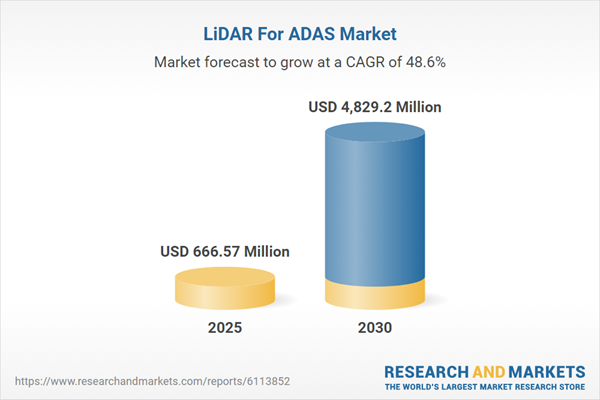LiDAR technology is pivotal in the advancement of Advanced Driver-Assistance Systems (ADAS), particularly for autonomous vehicles. Mounted typically on vehicle roofs, LiDAR sensors emit thousands of laser pulses per second, rotating 360 degrees to create real-time 3D maps of surroundings. These maps, generated through sophisticated machine learning algorithms, enable precise object detection, tracking, free space detection, road profile measurement, and localization, making LiDAR a cornerstone for ADAS functionality.
Market Drivers
The LiDAR market for ADAS is experiencing robust growth, primarily driven by the increasing demand for autonomous vehicles. Technological advancements, including adaptive algorithms, high-definition mapping, and enhanced sensor processing, are accelerating the production of self-driving cars. Autonomous vehicles offer significant benefits, such as enabling independent mobility for non-drivers and those with disabilities, enhancing traveler comfort, and allowing multitasking during commutes. Additionally, these vehicles promise increased safety by reducing crash risks and improving road capacity, which lowers operational costs. These advantages are expected to significantly boost the adoption of autonomous vehicles, thereby propelling the demand for LiDAR sensors.Regional Insights
North America holds a significant market share in the LiDAR for ADAS sector, driven by its rapid progression toward autonomous vehicle technology, particularly in commercial cars. The region's robust technological infrastructure and early adoption of ADAS systems further support market growth.Challenges
Despite its potential, the LiDAR market faces challenges, including technical limitations related to sensor range and resolution. The high cost of LiDAR sensors also hampers widespread adoption, as it increases the overall cost of vehicles equipped with ADAS.Opportunities
Significant investments in research and development are addressing these challenges by focusing on creating smaller, more affordable, and reliable LiDAR sensors with fewer moving parts. These innovations are expected to create substantial growth opportunities for the market by improving scalability and accessibility for automakers.The LiDAR market for ADAS is poised for significant growth, fueled by the rising adoption of autonomous vehicles and ongoing technological advancements. While challenges like high costs and technical limitations persist, continued R&D efforts and regional advancements, particularly in North America, are expected to bolster market expansion. As automakers like Mercedes-Benz push the boundaries of autonomous driving, LiDAR will remain a critical enabler of safer and more efficient transportation solutions.
Key Benefits of this Report:
- Insightful Analysis: Gain detailed market insights covering major as well as emerging geographical regions, focusing on customer segments, government policies and socio-economic factors, consumer preferences, industry verticals, and other sub-segments.
- Competitive Landscape: Understand the strategic maneuvers employed by key players globally to understand possible market penetration with the correct strategy.
- Market Drivers & Future Trends: Explore the dynamic factors and pivotal market trends and how they will shape future market developments.
- Actionable Recommendations: Utilize the insights to exercise strategic decisions to uncover new business streams and revenues in a dynamic environment.
- Caters to a Wide Audience: Beneficial and cost-effective for startups, research institutions, consultants, SMEs, and large enterprises.
What do businesses use our reports for?
Industry and Market Insights, Opportunity Assessment, Product Demand Forecasting, Market Entry Strategy, Geographical Expansion, Capital Investment Decisions, Regulatory Framework & Implications, New Product Development, Competitive IntelligenceReport Coverage:
- Historical data from 2022 to 2024 & forecast data from 2025 to 2030
- Growth Opportunities, Challenges, Supply Chain Outlook, Regulatory Framework, and Trend Analysis
- Competitive Positioning, Strategies, and Market Share Analysis
- Revenue Growth and Forecast Assessment of segments and regions including countries
- Company Profiling (Strategies, Products, Financial Information, and Key Developments among others).
LiDAR For ADAS Market Segmentation
By Type
- Solid-State LiDAR
- Electro-Mechanical LiDAR
By Autonomy Level
- Level 2
- Level 3
- Level 4
By Application
- Adaptive Cruise Control
- Lane Departure Warning
- Object Detection & Collision Avoidance
- Automatic Emergency Braking (AEB)
- Others
By Vehicle Type
- Passenger Vehicles
- Commercial Vehicles
- Light Commercial Vehicles
- Heavy Commercial Vehicles
By Geography
- North America
- United States
- Canada
- Mexico
- South America
- Brazil
- Argentina
- Others
- Europe
- UK
- Germany
- France
- Italy
- Spain
- Others
- Middle East and Africa (MEA)
- Saudi Arabia
- UAE
- Isreal
- Others
- Asia Pacific
- China
- Japan
- South Korea
- India
- Indonesia
- Thailand
- Taiwan
- Others
Table of Contents
Companies Mentioned
- Continental AG
- XenomatiX N.V.
- ams-OSRAM AG
- DENSO Corporation
- Valeo
- Ouster, Inc.
- Luminar Technologies, Inc.
- MicroVision
- Innoviz Technologies Ltd
- Aeva Inc.
Table Information
| Report Attribute | Details |
|---|---|
| No. of Pages | 141 |
| Published | June 2025 |
| Forecast Period | 2025 - 2030 |
| Estimated Market Value ( USD | $ 666.57 Million |
| Forecasted Market Value ( USD | $ 4829.2 Million |
| Compound Annual Growth Rate | 48.6% |
| Regions Covered | Global |
| No. of Companies Mentioned | 10 |









